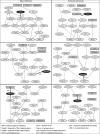Microstructure of Strategic White Matter Tracts and Cognition in Memory Clinic Patients with Vascular Brain Injury
- PMID: 29353280
- PMCID: PMC5972515
- DOI: 10.1159/000485376
Microstructure of Strategic White Matter Tracts and Cognition in Memory Clinic Patients with Vascular Brain Injury
Abstract
Background: White matter injury is an important factor for cognitive impairment in memory clinic patients. We determined the added value of diffusion tensor imaging (DTI) of strategic white matter tracts in explaining variance in cognition in memory clinic patients with vascular brain injury.
Methods: We included 159 patients. Conventional MRI markers (white matter hyperintensity volume, lacunes, nonlacunar infarcts, brain atrophy, and microbleeds), and fractional anisotropy and mean diffusivity (MD) of the whole brain white matter and of 18 white matter tracts were related to cognition using linear regression and Bayesian network analysis.
Results: On top of all conventional MRI markers combined, MD of the whole brain white matter explained an additional 3.4% (p = 0.014), 7.8% (p < 0.001), and 1.2% (p = 0.119) variance in executive functioning, speed, and memory, respectively. The Bayesian analyses of regional DTI measures identified strategic tracts for executive functioning (right superior longitudinal fasciculus), speed (left corticospinal tract), and memory (left uncinate fasciculus). MD within these tracts explained an additional 3.4% (p = 0.012), 3.8% (p = 0.007), and 2.1% (p = 0.041) variance in executive functioning, speed, and memory, respectively, on top of all conventional MRI and global DTI markers combined.
Conclusion: In memory clinic patients with vascular brain injury, DTI of strategic white matter tracts has a significant added value in explaining variance in cognitive functioning.
Keywords: Alzheimer disease; Diffusion tensor imaging; Small vessel disease; Strategic white matter tract; Vascular dementia.
© 2018 The Author(s) Published by S. Karger AG, Basel.
Figures


References
-
- Gorelick PB, Scuteri A, Black SE, Decarli C, Greenberg SM, Iadecola C, et al. American Heart Association Stroke Council Council on Epidemiology and Prevention, Council on Cardiovascular Nursing, Council on Cardiovascular Radiology and Intervention, Council on Cardiovascular Surgery and Anesthesia Vascular contributions to cognitive impairment and dementia: a statement for healthcare professionals from the American Heart Association/American Stroke Association. Stroke. 2011;42:2672–2713. - PMC - PubMed
-
- Prins ND, Scheltens P. White matter hyperintensities, cognitive impairment and dementia: an update. Nat Rev Neurol. 2015;11:157–165. - PubMed
-
- Baykara E, Gesierich B, Adam R, Tuladhar AM, Biesbroek JM, Koek HL, Ropele S, Jouvent E; Alzheimer's Disease Neuroimaging Initiative, Chabriat H, Ertl-Wagner B, Ewers M, Schmidt R, de Leeuw FE, Biessels GJ, Dichgans M, Duering M. A novel imaging marker for small vessel disease based on skeletonization of white matter tracts and diffusion histograms. Ann Neurol. 2016;80:581–592. - PubMed
-
- Nitkunan A, Barrick TR, Charlton RA, Clark CA, Markus HS. Multimodal MRI in cerebral small vessel disease: its relationship with cognition and sensitivity to change over time. Stroke. 2008;39:1999–2005. - PubMed
Publication types
MeSH terms
LinkOut - more resources
Full Text Sources
Other Literature Sources
Medical

